Bog Orchid Hammarbya paludosa… Tegeirian Siglen
July – August
Identification: 3– 10cm. Tiny spike growing out of a few small rounded leaves. Flowers less that 4mm long and held about 2cm above the leaves.
Similar species: None, but may be confused with grass stalks.
Habitat: Wet peaty runs of usually slowly flowing water amongst the sphagnum moss.
Distribution: Small numbers found in the upper Swansea valley and the Elan valley. Also on the moors of Ceredigion and Gwynedd.
Conservation issues: Over much of its range it is declining because of loss of habitat but the small numbers found at Welsh sites the numbers are stable, though variable from year to year.
Notes: Its small size makes this a particularly difficult orchid to find and because of this and the remoteness of its habitat it may well be under-recorded.

…………………………………………………
Autumn Lady’s-tresses Spiranthes spiralis … Ceineirian Troellog
August – September
Identification: 5 – 15cm. The straight, narrow inflorescence carries a spiral of small pure white flowers. The stalk is a grey-green colour and covered with hairs. A few leaves sheath the stem but the most prominent leaves are found as a small tight rosette to one side of the spike.
Similar species: There is no similar species in Wales
Habitat: Because of its small size it is restricted to short, usually calcareous, turf.
Distribution: In Wales it is mainly, though not exclusively, a coastal species. There are reasonable populations in the south east of the principality with smaller numbers extending to the Gower and Pembrokeshire.
Conservation issues: The species has been badly affected by changes in agriculture l and has been lost from large areas of the Vale of Glamorgan.
Notes: Appearance of species marks the end of the “orchid season” although flower spikes now seem to be appearing earlier and are gone by October.
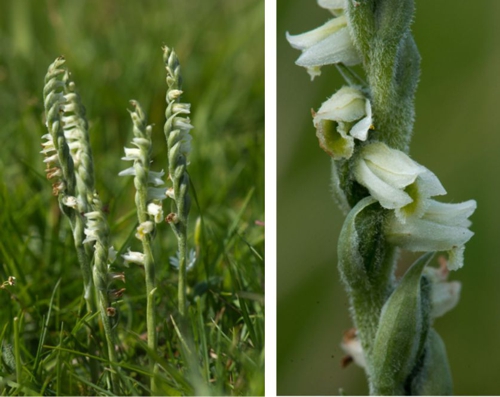
…………………………………………………
Early Purple Orchid Orchis mascula … Tegeirian Coch
April – May
Identification: 15 – 35cm. The bright red-purple flowers carry white markings on the lips make a striking inflorescence. Pale or even white flowers are not uncommon. The flowers are large with a three-lobed rounded lip usually with a few spots in the centre. Behind the lip is a long upward- pointing spur. The sepals form a hood over the column. The leaves are usually, though not always, spotted sometimes heavily. Plants growing in woodlands are usually taller with fewer, lax flowers.
Similar species: The Green-winged Orchid flowers at about the same time but is usually rather squat, has darker flowers with prominent veined wings. The Marsh Orchids although superficially similar, appear much later than the Early Purple Orchid.
Habitat: Found in a variety of habitats from grassy roadside verges to shaded woodlands and open, generally drier, sand dunes.
Distribution: Found only in reasonable numbers in parts of the Gower, Pembrokeshire and around the Cardigan coast. Also found on the Lleyn peninsular and sites on the north Wales coast and Anglsey.
Conservation issues: None
Notes: The first orchid to appear in the spring. To some people it has an unpleasant odour.
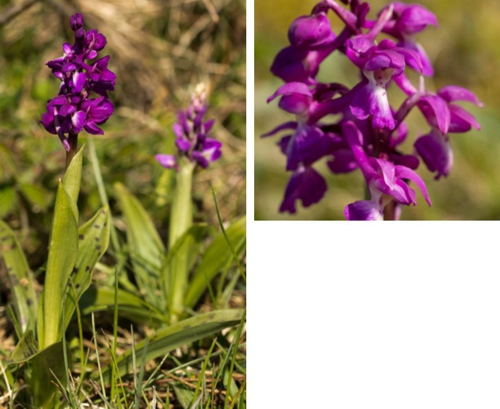
…………………………………………………
Small White Orchid Pseudorchis albida … Tegeirian Broga Gwyn
May – Early June
Identification: 7 – 15cm. The tiny inflorescence is topped by a tight spike of rounded white flowers. The leaves are clustered around the base of the stem.
Similar species: None.
Habitat: Restricted to grassy hill pastures.
Distribution: Once thought to be restricted to a few sites in mid and North Wales but more recently has been recorded at a few sites in the south of the country.
Conservation issues: Very local and possible declining.
Notes: This orchid is found in greatest numbers in the hilly areas of northwest Scotland.
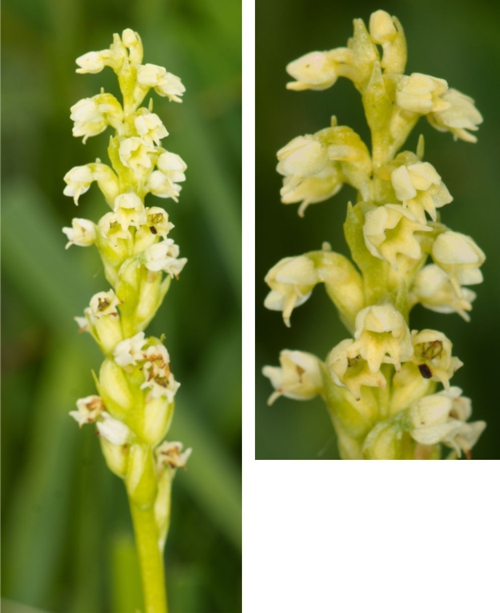
………………………………………………….
Lesser Butterfly-orchid Platanthera bifolia … Tegeirian Llydanwyrdd Bach
Late May – June
Identification: 12 – 20cm. Similar to the Greater Butterfly-orchid but with the pollinia parallel in the flower.
Similar species: There is some overlap in the sizes of the two species and the Lesser Butterfly-orchid is slightly yellower in colour. The best distinction is the shape of the pollinia.
Habitat: Favours acidic soils where it can sometimes be found on moorlands with the Heath Spotted-orchid.
Distribution: In Wales it is found mainly to the west of the country with reasonable populations in Pembrokeshire and Cardiganshire. Smaller numbers occur in Breconshire and Anglesey.
Conservation issues: At the moment populations appear to be stable.
Notes: Interestingly, the two species appear to be morphologically different and they seem to be reluctant to hybridise freely, however DNA analysis cannot distinguish between the two species.
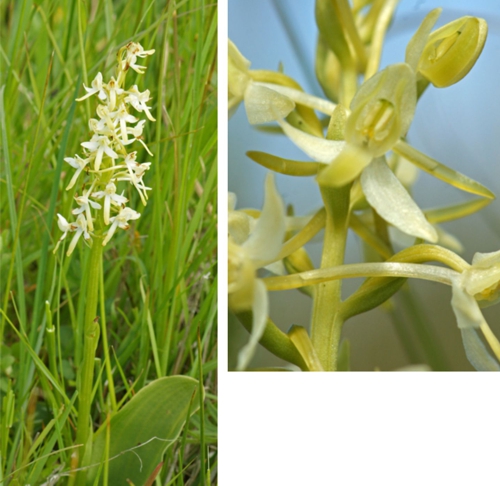
…………………………………………………
Greater Butterfly-orchid Platanthera chlorantha … Tegeirian Llydanwyrdd
May – June
Identification: 20 – 30cm. The inflorescence is a dense collection of large white flowers each one having an overall white colouration although the lip and the two small sepals are greenish. Behind each flower is an extremely long spur curving downwards. There are two large leaves which can be difficult to see amongst other herbage.
Similar species: Only the Lesser Butterfly-orchid is similar. This species is generally smaller with the pollinia lying parallel between the petals whereas in the Greater species they are distinctly “A” shaped.
Habitat: Mainly on calcareous grasslands, this may be open meadows or in shaded woodland.
Distribution: Found locally throughout most of the country though somewhat rarer in the South of the country. Generally found in small numbers although occasionally in large colonies.
Conservation issues: Loss of hay meadows has led to some decline in numbers but current populations are holding.
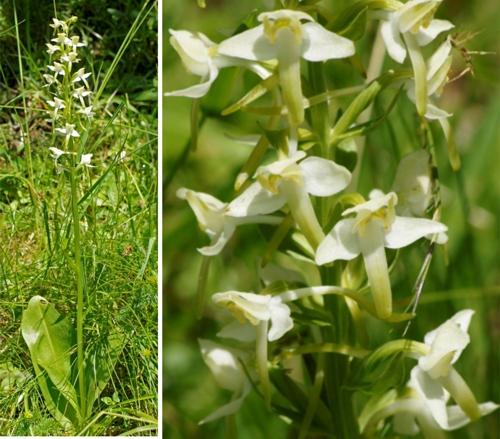
…………………………………………………